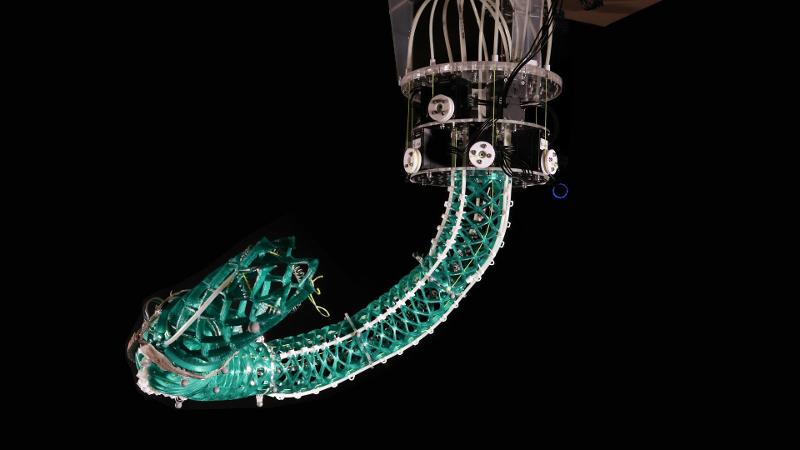Drawing inspiration from the movements of elephant trunks and octopus tentacles, researchers at the Swiss Federal Institute of Technology Lausanne (EPFL) have developed a groundbreaking robotic structure called the 'trimmed helicoid.' This innovative design blends computational modeling with astute biological observations to create a structure that enhances compliance and control in robotics. In this article, we will explore how this structure revolutionizes human-robot interactions and opens up new possibilities in the field of robotics.
The Inspiration: Nature's Ingenious Movements
Discover how the movements of elephant trunks and octopus tentacles have inspired the development of the trimmed helicoid robotic structure.
Nature has always been a source of inspiration for scientists and engineers. The way elephants use their trunks and octopuses manipulate their tentacles with remarkable dexterity has fascinated researchers for years. These natural movements have now paved the way for the development of a revolutionary robotic structure known as the trimmed helicoid.
The trimmed helicoid design mimics the flexibility, compliance, and control observed in nature. By studying and emulating these ingenious movements, researchers have created a structure that enhances the capabilities of robots, making them safer and more adaptable in various applications.
Blending Computational Modeling and Biological Observations
Explore how computational modeling and astute biological observations have been combined to create the trimmed helicoid robotic structure.
The development of the trimmed helicoid involved a unique blend of computational modeling and biological observations. Researchers at the Swiss Federal Institute of Technology Lausanne (EPFL) collaborated with the Department of Cognitive Robotics at TU Delft to bring this innovative structure to life.
By leveraging computational modeling techniques, the researchers were able to simulate and analyze the intricate movements of elephant trunks and octopus tentacles. These simulations, combined with astute biological observations, provided valuable insights into the mechanics and dynamics of natural movements.
Through this interdisciplinary approach, the team was able to translate their findings into a practical robotic structure that exhibits enhanced compliance and control, opening up new possibilities in the field of robotics.
Enhancing Human-Robot Interactions
Learn how the trimmed helicoid design ensures safer and more effective interactions between humans and robots.
One of the key advantages of the trimmed helicoid robotic structure is its ability to enhance human-robot interactions. Traditional rigid robotic structures can pose a safety risk when working in close proximity to humans. However, the trimmed helicoid's flexible and compliant design mitigates this risk, making it safer for humans to interact with robots.
Additionally, the trimmed helicoid's improved control and adaptability enable robots to perform tasks with greater precision and efficiency. This opens up new possibilities for collaborative work environments where humans and robots can work together seamlessly.
With the trimmed helicoid design, the future of human-robot interactions looks promising, with robots becoming valuable assistants in various industries, from healthcare to manufacturing.
Applications and Future Implications
Discover the potential applications and future implications of the trimmed helicoid robotic structure.
The trimmed helicoid design has the potential to revolutionize various industries and fields where robots play a crucial role. Its enhanced compliance and control make it suitable for applications such as healthcare, where robots can assist in delicate procedures with precision and care.
In manufacturing, the trimmed helicoid structure can improve the safety and efficiency of human-robot collaboration on the factory floor. Its adaptability and compliance allow robots to handle delicate materials and perform intricate tasks with ease.
Looking ahead, the trimmed helicoid design opens up new avenues for research and development in the field of robotics. By further refining and expanding upon this innovative structure, we can expect to see even more advanced and capable robots in the future.
Conclusion
The development of the trimmed helicoid robotic structure marks a significant milestone in the field of robotics. By drawing inspiration from nature's ingenious movements, researchers have created a design that enhances compliance and control in robots, making them safer and more adaptable in various applications.
The blended approach of computational modeling and biological observations has led to the creation of a structure that not only mimics natural movements but also improves human-robot interactions. The trimmed helicoid design opens up new possibilities for collaborative work environments and has the potential to revolutionize industries such as healthcare and manufacturing.
As we continue to refine and expand upon this innovative structure, we can expect to see even more advanced and capable robots in the future. The trimmed helicoid paves the way for a new era of robotics, where machines can seamlessly integrate into our lives and assist us in various tasks.
FQA
How does the trimmed helicoid design enhance human-robot interactions?
The trimmed helicoid design enhances human-robot interactions by providing a flexible and compliant structure. This makes robots safer to work with in close proximity to humans. Additionally, the improved control and adaptability of the trimmed helicoid design enable robots to perform tasks with greater precision and efficiency.
What are the potential applications of the trimmed helicoid robotic structure?
The trimmed helicoid robotic structure has potential applications in various industries. In healthcare, robots can assist in delicate procedures with precision and care. In manufacturing, the structure improves the safety and efficiency of human-robot collaboration. The adaptable and compliant design of the trimmed helicoid opens up possibilities for its use in other fields as well.
How does the trimmed helicoid design differ from traditional rigid robotic structures?
Unlike traditional rigid robotic structures, the trimmed helicoid design offers enhanced compliance and control. This flexibility allows robots to handle delicate materials and perform intricate tasks with ease. The trimmed helicoid design also mitigates safety risks when working in close proximity to humans, making it a safer option for human-robot interactions.

